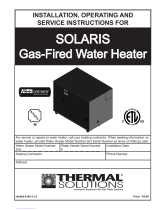2 Polypropylene (PP) Common Venng Installaon Instrucons
This manual provides installaon instrucons for
Ubbink Polypropylene (PP) common venng and is a
supplement to the Installaon and Operaons Manual
supplied with the Rinnai Tankless Water Heater.
Common venng must sasfy all the requirements of
the Installaon and Operaons Manual, as well as the
requirements in this manual.
For detailed informaon on the Rinnai Tankless Water
Heater, including installaon instrucons, refer to the
Tankless Water Heater Installaon and Operaon
Manual or view an online version at rinnai.us.
Welcome .................................................................... 2
Safety ......................................................................... 3
About the Common Venng System ............................ 4
Venng Guidelines ...................................................... 4
High Altude Installaons ........................................... 5
3 in. Common Venng ................................................ 6
3 in. Direct Vent and Room Air .................................... 6
3 in. Inline and Corner Kits .......................................... 7
4 in. Common Venng ................................................ 8
4 in. Direct Vent and Room Air .................................... 8
4 in. Inline Add-On and Starter Kits ............................. 9
4 in. Back-to-Back Add-On and Starter Kits ............... 10
6 in. Common Venng .............................................. 11
6 in. Direct Vent and Room Air .................................. 11
6 in. Inline Add-On and Starter Kits ........................... 12
6 in. Back-to-Back Add-On and Starter Kits ............... 13
Terminaon Kits ....................................................... 14
Common Vent Components ...................................... 15
Sample Horizontal Terminaon Assembly ................. 16
Sample Vercal Terminaon Assembly-Room Air ..... 17
Maintenance Clearances ........................................... 18
Combuson Air Requirements .................................. 20
Exhaust Vent Terminaon Clearances ....................... 23
Addional Clearances ............................................... 25
Installaon Instrucons ............................................ 26
Final Checklist ........................................................... 29
Appendix A — Ubbink Condensing System ................ 30
• This manual is intended for the trained and
qualied professional and is designed for licensed
installers who should have skills such as:
− Gas sizing
− Connecng gas lines, water lines, valves, and
electricity
− Knowledge of applicable naonal, state, and
local codes
− Installing venng through a wall or roof
− Training in installaon of tankless water heaters.
Training on Rinnai Tankless Water Heaters is
accessible at www.trainingevents.rinnai.us
• A trained and qualied professional must test the
Common Venng System for leaks before use.
• The installaon must conform to the Rinnai
Tankless Water Heater Installaon and Operaon
Manual that is shipped with the unit, local codes, or
in the absence of local codes, with the Naonal
Fuel Gas Code, ANSI Z223.1/NFPA 54.
• Read all instrucons contained in this manual
before installing the Common Venng System.
• Proper installaon is the responsibility of the
installer.
• When installaon is complete, give all manuals
related to the common venng installaon
(including this manual and the Rinnai Tankless
Water Heater Installaon and Operaon Manual)
directly to the consumer. The manuals should be
stored in a readily accessible locaon for future
reference.
Contact your local dealer/distributor, or call Rinnai
Customer Care at 1-800-621-9419 Monday to Friday
between 8 AM to 8 PM EST.
• Keep this manual for future reference.
• Be sure your Common Venng System is installed
by a trained and qualied professional.





















